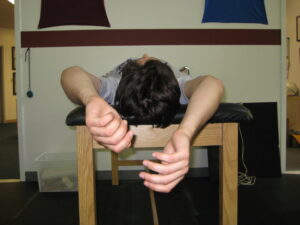The Rocker Inferior Capsule Stretch
One of the most common functional limitations we see in those with shoulder issues is the inability to achieve full overhead range of motion. This can occur due to soft tissue restrictions (lat, pec minor, long head of triceps, among others), weakness (lower traps, serratus anterior), joint restrictions (thoracic spine), or a combination of several of these factors. The end result is often that a quick assessment reveals something like this:

In a “healthy” shoulder, with the lower back flat, both upper arms should be flat on the table. This is a great position to quickly check what’s going on and eliminate the muscular strength side of things, as gravity does the work for you as the arms flop down.
The question, of course, is how do you fix it once it’s there? Well, the truth is that there are several things you’d need to do a few different assessments to see exactly what’s up, and while that’s beyond the scope of an individual article, we can touch on one of them with some detail – thanks to Tim DiFrancesco, a great physical therapist who provided today’s guest post below. From Tim:
I developed the inferior capsule rocker stretch to address limited mobility of the glenohumeral joint’s inferior capsule. This limitation is often a major factor in dysfunctional shoulders of overhead athletes and/or those performing regular overhead activities of daily living. It is appropriate and necessary to assess inferior capsule mobility in those performing regular over-head activities as well as when there is a shoulder pathology suspected.
Inferior capsule integrity can be assessed with an inferior glide looking at accessory joint motion. This is paramount to address with these populations due to the fact that a restricted inferior capsule is often associated with superior humeral-head migration. Impingement then results.
To perform the stretch:
1. Begin in quadruped position and rock hips back to heels (place pad under knees). Hands flat on the floor in front.
2. Reach the right arm out into flexion/elevation in pronated position (fixing the scapula and locking the thoracic spine).

3. Roll the palm open into a supinated position (decreasing the chance of subacromial impingement).
4. Slide the arm out into the scapular plane (decreasing the amount of stress on the rotator cuff tendons and surrounding soft tissue structures).
5. Reach the left hand under the right axillary (armpit) region (cupping the latissimus dorsi).

6. Rock or shift the body weight into the right shoulder until a strong but comfortable stretch is felt in the right axillary region.
7. Hold for 30-60 seconds without pain. If pain is noticed in one focal location at the anterior/superior aspect of the shoulder, then reposition the shoulder into more precise supination and scaption.
You can also perform a similar stretch with the arm crossing the body (adduction).
Timothy DiFrancesco, PT, DPT, ATC, CSCS graduated from Endicott College in 2003 with his Bachelor’s degree in science/athletic training. While at Endicott Tim was a four year member of the varsity men’s basketball team. Tim immediately went on to the University of Massachusetts Lowell where he earned his Doctorate of Physical Therapy in 2006.
In 2007, Tim co-founded TD Athletes Edge, LLC, which offers a systematic, results-driven approach to performance training and rehabilitation. In addition to his work as President of TDAE he currently works as a physical therapist on Boston’s Northshore and is an adjunct faculty member at Salem State College. He recently accepted the position as the Head Athletic Trainer and Strength & Conditioning Coach with the NBA D-League Bakersfield Jam. Tim has a passion for working with athletes and patients of all levels to help them achieve their goals and reach their performance potential.
Sign-up Today for our FREE Baseball Newsletter and Receive a Copy of the Exact Stretches
used by Cressey Performance Pitchers after they Throw!


